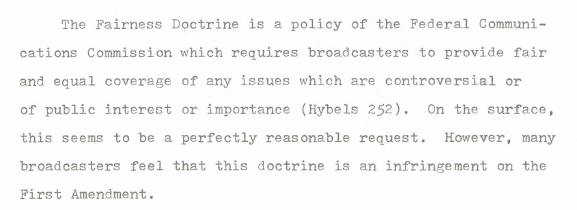|
Communications Law with Mary Alice Molgard was one of the classes at the College of St. Rose that most intimidated me.
My paper, titled “The Fairness Doctrine: FCC Regulations and the First Amendment” is undated, but since Mary Alice joined the faculty in 1985, it was likely written between 1986 and 1988. In fact, the FCC abolished the doctrine by a 4–0 vote on August 5, 1987, and I did my internship at Sawchuk Brown Associates that fall, so I’m going to guess I wrote this as a junior in Fall ‘86 or Spring ‘87. The opening paragraph is pictured above, and you can read all 11 pages of my Baby Writer glory here. (I got an A!) I’ve been thinking a lot about the Fairness Doctrine lately. The American political landscape is deeply divided with each side thinking the other is not only wrong but very likely evil. In January 2019, Kevin M. Kruse and Julian Zelizer of the Washington Post wrote an article titled “How Policy Decisions Spawned Today’s Hyperpolarized Media,” subtitled “The demise of the Fairness Doctrine played an underappreciated role in fomenting media tribalism.” The article makes very clear that American broadcasting history rests on the fulcrum of the Fairness Doctrine. “In 1987, the FCC announced that it would no longer enforce the Fairness Doctrine. The Democratic Congress tried to restore the doctrine, but Reagan vetoed the bill. “Almost overnight, the media landscape was transformed. The driving force was talk radio. In 1960, there were only two all-talk radio stations in America; by 1995, there were 1,130. While television news on the old networks and the cable upstart CNN still adhered to the standard of objectivity, radio emerged as a wide-open landscape.” And it’s not just talk radio. The article continues: “Cable television had never been subject to the Fairness Doctrine, and, indeed, its growth had been a key rationale for ending the policy. But it was transformed by the changes all the same. Seeing the massive audiences that conservative talk radio attracted, cable television entrepreneurs realized that they, too, could thrive by providing the news from a partisan perspective. In 1996, Rupert Murdoch launched Fox News, placing Roger Ailes in charge of the operation. A longtime media consultant for Republicans, Ailes had worked on both of George H.W. Bush’s presidential campaigns and then produced Limbaugh’s television program from 1992 to 1996.” And now, 20 years on, we have social media to contend with. It's a step in the right direction for Twitter and Facebook to slap warning labels on “untruths” from the President – whether about the election or the pandemic – but maybe it’s time to consider replacing some of the guardrails on public discourse. What do you think? Is it time to revisit the Fairness Doctrine? Drop me a line – let’s make #SmallTalk!
Gail
11/21/2020 08:26:57 pm
I agree. The Fairness Doctrine is no longer appropriate. Comments are closed.
|
AuthorColleen M. Ryan is an Archives
September 2022
Categories |


 RSS Feed
RSS Feed
